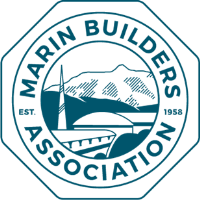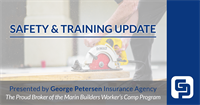Celebrating our Member Referral Partners - Thank You for Helping Us Build Our Community!
We would like to recognize and celebrate our wonderful REFERRAL PARTNERS!2025:Barbara Bicknell, Raully Jones Construction, who referred North End Plumbing Heating & Air (Special thanks to Barbara, who pledged her bonus to our Workforce Development & Scholarship Fund!) Clare Michael, Clare Michael Interiors, who referred Justin Muller, Leff Design BuildMaddie Lewis, BBC Construction, who referred Kate DeWitt, Kate DeWitt DesignKasey Curry, R.C Electric, who referred Connacht Construction (Special thanks to
Safety & Training Short: Head Protection
Objective: To familiarize employees with common types of head protection and best practices for their use. The brain is the control center of your body. If it’s damaged in any way, your entire body will be at risk! Normally, your skull protects your brain from injury, but when falling or flying objects are a hazard, additional protection must be worn.Common Hazards that Require Head Protection Workplace hazards that could cause injury to the head include: Falling objectsContact with protruding or fixed
Safety & Training Short: Carbon Monoxide Safety
Objective: To reinforce awareness of the potential hazards of carbon monoxide exposure.Carbon Monoxide Dangers Carbon monoxide (CO) is often referred to as a “silent killer” because our senses can’t easily detect it. When inhaled, CO displaces oxygen from the bloodstream and can be fatal. CO is also flammable in high concentrations. CO poisoning victims can survive if their symptoms are recognized early and immediate action is taken.Click here to download the training short in EnglishClick here to download
Safety & Training Short: Winter Preparation
In cold, wet conditions, common dangers include slips and falls, as well as vehicle accidents. Taking simple precautions can prevent accidents and injuries.Preventing slips: Areas that may become slick and require extra caution include stairs, ramps, tile floors, parking lots and metal parts of equipment. Have an excellent snow and ice removal program in place.Place non-skid floor mats and caution signs in slippery, high traffic areas.Use traction devices that strap onto shoes when conditions require
Safety & Training Short: Cybersecurity for Small Businesses
Objective: To inform organizations of measures they can take to increase the security of their data, computer, and network systems. The advancement of information technology has made it easier than ever to run a small business, but your organization as well as your customers and their data may be at risk unless proper cybersecurity measures are in place.Click here to download the training short in EnglishClick here to download the training short in Spanish Safety & Training Shorts provided by George
Marin Builders Association Members: Save on your Workers' Comp!
Thank You to our 2025-26 Marin Home Resource Guide Ad Partners!
We want to express our deep gratitude to our wonderful 2025-26 Marin Home Resource Guide Ad Partners! Their generous support of our signature publication made this edition possible - and our best yet! Your partnership is instrumental in supporting our local building community and connecting with Marin County homeowners preparing to undergo their next home improvement project.Celebrating in alpha order:A and P Moving, Inc.Aaero Heating & Sheetmetalbuilding LabCanty Real Estate Group, IncCentral Valley






